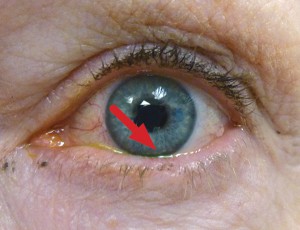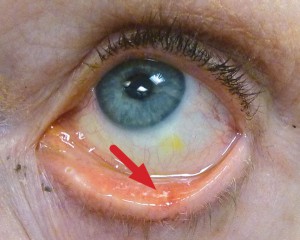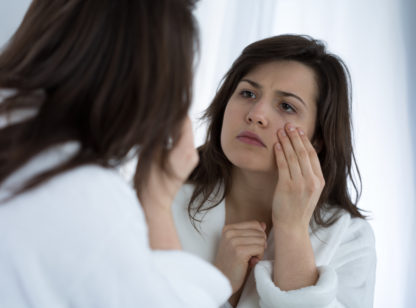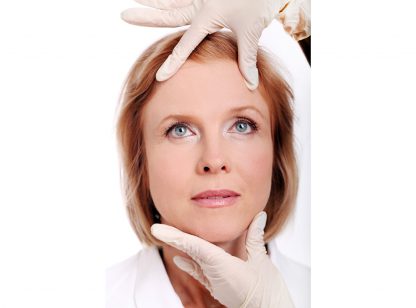Skin cancer can be quite common here in the Coachella Valley. Our beautiful weather also brings with it intense ultraviolet exposure. Cumulative exposure to UV rays is the most significant cause of skin cancer, and our eyelids are no exception.
The eyelids are among the thinnest, most delicate tissues of the body and are an important part of ocular health. They protect the eyes from foreign bodies and trauma and help to keep them well lubricated.

This patient noticed an irregular area in the center of her left lower lid for 1 year prior to diagnosis of basal cell carcinoma.
Like skin elsewhere on our bodies, our eyelids are often prone to developing small growths. Most often, these lesions are benign entities such as nevi (moles) or skin tags. Some growths, however, are cause for concern. Enlargement or changes in appearance are two key factors. These changes occur slowly and go unnoticed for a prolonged period. Other important changes are altered architecture of the eyelid margin or loss of eyelashes (madarosis). The eyelid margin is the portion of the eyelid where the skin meets the moist inner surface of the eyelid. The lashes emanate from the eyelid margin. Skin cancers may cause irregularity or ulceration of the margin’s surface and may manifest as a small non-healing area, or an area that periodically bleeds and crusts (figure 1a and 1b). Other presentations include the presence of a lesion that recurs following treatments such as cryotherapy (freezing) or excision.
Prevention is key when considering skin cancers. A broad spectrum sunscreen that blocks both UVA and UVB rays is recommended on exposed skin. A sun protection factor of at least 30 is ideal. Sunscreen should be applied prior to any vigorous activity so it has time to set into the skin. Thirty minutes is ideal if swimming or heavy perspiration is anticipated. Sunscreen should be applied liberally to ensure proper coverage. Adequate amounts will require repeated smoothing over the skin. You should begin with enough sunscreen to cause a milky film on the skin that requires numerous motions to work it onto the area. Sunscreen should be applied to all exposed areas, including the nose, ears, top of scalp, backs of hands, soles of feet and neck.
And reapplication is key. Too often we forget to reapply, or think that since we applied so much the first time, it will last all day. With activity, perspiration will cause loss of protection and the sun’s UV rays can break down the protective ingredients of the sunscreen. As such, sunscreen should be reapplied every 2 to 3 hours.

The affected inner surface of the eyelid is more irritated and inflamed than surrounding areas.
But don’t forget your eyelids! Sunglasses that block UVA and UVB rays and are large enough to fully cover the eyes and periocular areas are the most beneficial. When purchasing sunglasses, take shape into consideration. Ideally, sunglasses should wrap around the eyes. Also take into consideration the types of activities and times of day you are planning to use them. For example, if you will be playing golf or tennis midday, make sure they are large enough to block the sunlight that is directly over your head. If you do not feel sunglasses alone are adequate, the addition of a broad brimmed hat is recommended.
Sunglasses and hats also protect the eyes from the sun’s harmful rays. Cataract progression may be slowed with prolonged and diligent use of sunglasses and/or hats. In those people who are more prone to develop macular degeneration (family history), UV protection is also beneficial in protecting the retinas from toxic insult.
Any suspicious lesion of the eyelid should be evaluated. Signs which cause concern include enlargement, change in appearance, and alteration of architecture or loss of lashes. Persistent inflammation and recurrence are also important factors.
Early diagnosis and treatment are key in eyelid malignancies. Appropriate management is important in eradicating the tumor while maintaining as much normal tissue as possible. If skin cancer is diagnosed and is localized to the eyelid, removal is usually indicated. This can be performed by the Oculoplastic surgeon, or by a dermatologist trained in the Mohs technique. Once the cancer is removed, the eyelid must be reconstructed to ensure optimal function and appearance. Lesions in this region can be difficult to see and are often overlooked. Any area of concern should be evaluated, preferably by a physician who is specially trained in this eye region.
Dr. Hui is the founder of The Eyelid Institute in Palm Desert. She is an Oculoplastic surgeon and has a special interest in helping patients with Eyelid, Lacrimal and Orbital conditions. An Oculoplastic surgeon is a physician with combined training in Ophthalmic Plastic and Reconstructive Surgery (Oculoplastics) and Ophthalmology who has unique abilities to perform a variety of delicate procedures around the eyes. Dr. Hui can be reached at 760.610.2677.












































Comments (0)